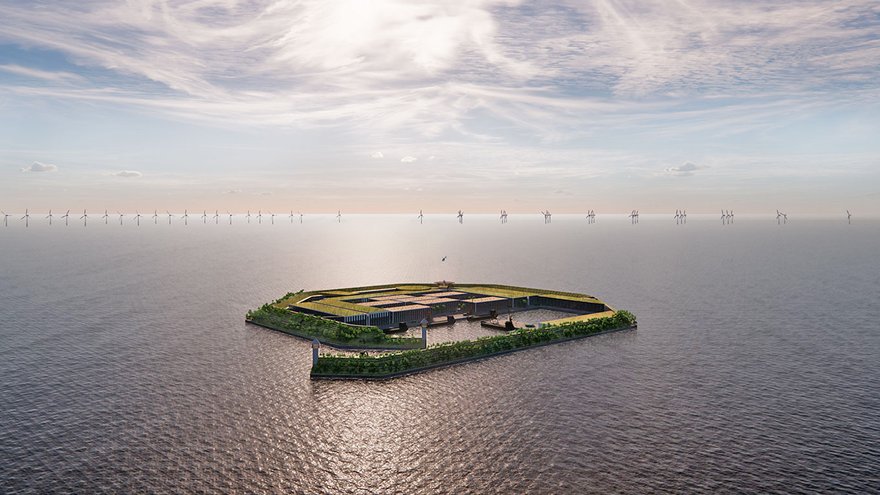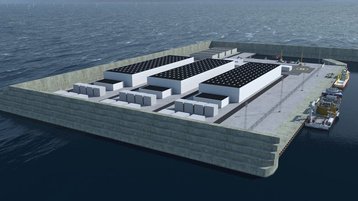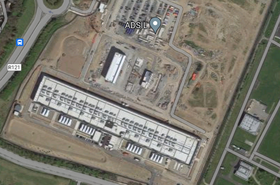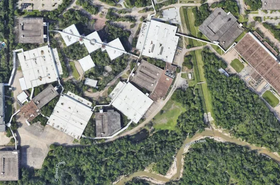It's now near-universally accepted that the world needs to move swiftly to renewable energy - indeed, according to the UN, global emissions need to be reduced by almost half by 2030 and reach net zero by 2050 if we're to avoid the worst impacts of climate change.
However, there's rather less agreement on how this is to be achieved. While renewable energy sources such as wind, tides, and solar power have in theory almost unlimited potential, appropriate sites aren't always easy to find.
In the case of wind, lack of suitable space and local objections are a major limitation when it comes to onshore installations. Meanwhile, at sea, turbines face a trade-off that can limit their viability.
Close to the shore, they face local opposition, and meanwhile generally experience less powerful and more intermittent wind. But siting them further out, where the sea is deeper, presents significant structural problems.
A new land
One potential solution that's now receiving serious attention is to create 'energy islands' - artificial islands sited well offshore that would house large numbers of wind turbines.
The energy produced could be stored in batteries or transmitted to shore via hybrid interconnectors to multiple landing points. These allow the creation of an interconnected offshore wind grid, making electricity from the wind farm available wherever it's needed. When electricity isn't being produced through lack of wind, the same interconnectors will allow countries to trade electricity.
The wind energy could also be converted to hydrogen via electrolyzers; these could either be sited on the island itself, with the hydrogen piped back to shore, or on the mainland, where the excess heat from the process could be fed into district heating networks to heat homes.
The biggest cheerleader for energy islands is the Danish Energy Agency (ENS), which is leading a project to build two islands, one in the North Sea and one in the Baltic Sea. The successful bidders will be announced this year (2024).
"Denmark has a lot of coastline, and the North Sea particularly is a fantastic area for offshore wind projects - very windy and with relatively shallow waters," says a spokesperson.
The North Sea and the Baltic
The North Sea installation will be built on an artificial island around 80km off the coast of Thorsminde, a town in Jutland, and will serve as a hub for a number of offshore wind farms. It will house facilities for routing electricity from the wind turbines into the electricity grid and, potentially, a harbor and service facilities for the first 3-4GW of electricity generation.
This 3GW capacity represents twice as much energy as the total offshore capacity of wind turbines in Denmark today and around half of the country's total electricity consumption. Later, says the ENS, there are plans to expand capacity to up to 10GW.
The project involves two major firsts - turbines which are larger than existing installations, and sited further from the coast than has been attempted before.
Meanwhile, the Baltic Sea island is less extreme. It will be built on an existing natural island, Bornholm, around 15km off the coast, where electricity from offshore wind farms will be routed to electricity grids in Denmark and neighboring countries. The turbines will have a capacity of 3GW.
In the case of both islands, the aim is to convert electricity from the offshore wind farms into other forms of energy, such as Power-to-X, as well as to house equipment that can store surplus electricity when the supply of electricity exceeds demand.
[At time of writing in 2023] The projects are currently up for tender, with two consortia openly bidding.
Modular island building
One bidder consists of Danish multinational power company Ørsted, along with Denmark's largest institutional investor ATP and digital infrastructure and connectivity company GlobalConnect.
Jesper Kühn Olesen, project director for Ørsted’s the North Sea Energy Island proposal, envisages a 'future proof' construction, based on a modular approach.
"It consists of a small artificial island, which can be expanded with flexible modules that can be added and replaced as required," he says.
"The modules are built onshore and connected to the North Sea Energy Island, meaning that the island can easily be upgraded to accommodate more than the 10GW of offshore wind power that is Denmark’s current ambition. It can also be adapted to accommodate the rapid developments in Power-to-X and other technologies in both 2030, 2050 and after."
Meanwhile, one other bidder for the project has publicly entered the fray: the VindØ consortium consists of two of Denmark’s largest pension funds, PensionDanmark and PFA, along with its largest utility company, Andel, and infrastructure investment firm Copenhagen Infrastructure Partners (CIP).
This group foresees carrying out electrolysis on the island itself, claiming that it's cheaper to lay a hydrogen pipeline to the mainland than a power cable, and is also considering the production of ammonia to be used in shipping and industry.
It's not clear whether any other bidders have expressed an interest: "Both consortiums have been very explicit about their interest in the North Sea Energy Island in particular. But we are still preparing the tender documents and can’t say more about potential bidders at this stage," says the ENS spokesperson.
Data center proposals
While data centers aren’t a major part of official plans, both consortia have expressed interest in housing them on the energy islands, with the Ørsted group envisioning their proposals acting as digital hubs as well as energy hubs.
"On the island, a data center can directly access renewable energy on a large scale from the connected windfarms and at the same time be placed on an intersection for the fiber grid that sends data through the North Sea region," says a GlobalConnect spokesperson.
"Being placed in the middle of an ocean will also provide a generally cooler area, which will lessen the data center’s need for cooling, while the ocean offers submerged cooling possibilities."
Denmark is open about its ambitions to take a lead in the creation of energy islands, in much the same way as it has pumped resources into wind power in the past.
Beyond the two current projects, it is leading in a more distant project, BrintØ or 'Hydrogen Island' planned for the shallow waters of Dogger Bank on the Danish side of the North Sea, connected to 10GW of offshore wind power and with a green hydrogen production capacity of around one million tons. The hydrogen will be sent to neighboring nations such as Germany, the Netherlands and Belgium.
Enter Belgium
While its plans are the most extensive, Denmark is not the only country to be looking into the possibilities of energy islands.
A Belgian consortium, TM Edison, has won the tender from electricity transmission system operator Elia for the construction of an artificial energy island, again in the North Sea, but this time off the coast of Belgium.
Princess Elisabeth Island will be located 45km from the coast within the Princess Elisabeth wind zone. The idea is to connect a 3.5GW wind zone with the UK and Denmark through the Nautilus and TritonLink interconnector projects, as well as Belgium itself.
The plan is to link all wind farms in the zone to the mainland by 2030, and ultimately to generate 300GW of offshore electricity by 2050.
Construction of the foundations is set to start this year and is expected to take two and a half years, with the high-voltage infrastructure installed after that. It will, says the team, be the world’s first artificial energy island to combine both direct current (HVDC) and alternating current (HVAC) facilities.
"This project is a pioneering one for several reasons. It is the most cost-effective and reliable way to bring offshore wind to shore. It will be an island that provides options for the future," says Chris Peeters, CEO at Elia Group.
"When we connect it to other countries, the Princess Elisabeth Island will become the first offshore energy hub. After our construction of the first hybrid interconnector in the Baltic Sea, the island is another world first."
Pushing the technology
Energy islands will require a number of advanced and little-tested technologies - the construction of the islands themselves, the building of larger-than-usual turbines and the positioning of large-scale hydrogen electrolyzers far out at sea.
However, with the total potential of the North Sea alone in terms of offshore wind generation estimated at 180GW - around a third of the total wind power that the EU is aiming to achieve by 2030 - the prize is a big one.
"The energy islands will be a huge step in the transition towards more green, renewable energy and secure energy supply – not only in Denmark but in Northern Europe," says the ENS spokesperson.






